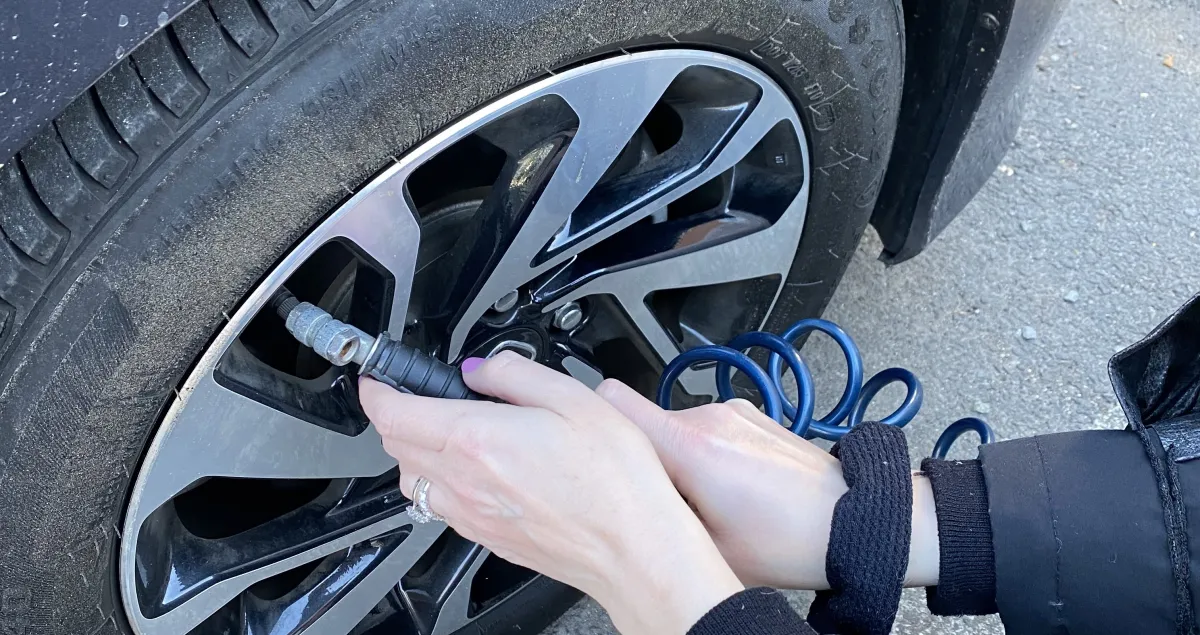Keeping Your Ride Rolling: A Comprehensive Guide to Inflating Tires at Gas Stations
Proper tire inflation is a crucial aspect of safe and efficient driving. Underinflated tires can lead to a variety of problems, including decreased fuel economy, uneven tire wear, and compromised handling. Fortunately, maintaining proper air pressure is a relatively simple process that can be done at most gas stations. This guide will walk you through the steps involved in inflating your tires at a gas station, equip you with valuable tips, and address frequently asked questions.
Before You Begin: Knowing Your Tire Pressure
- Locate Your Recommended PSI: Your car’s recommended tire pressure, measured in pounds per square inch (PSI), can be found in several locations:
- Driver’s side door placard: This sticker typically resides on the driver’s side door jamb, revealing the recommended PSI for both front and rear tires.
- Owner’s manual: Consult your car’s manual for detailed information on tire pressure specifications.
- Tire sidewall: The recommended PSI might also be printed directly on the sidewall of your tire.
Important Note: The recommended PSI may differ between fully loaded and unloaded vehicles. Make sure you identify the correct value based on your driving situation.
- Invest in a Tire Pressure Gauge: A reliable tire pressure gauge is an essential tool for maintaining proper tire inflation. These are readily available at auto parts stores and online retailers for a reasonable price. Opt for a digital gauge for ease of use.
Gearing Up for Inflation: Tools and Supplies
- Locate the Air Inflation Station: Most gas stations have a designated air inflation station equipped with a pressure gauge and air hose. Look for signage or a dedicated area with an air compressor.
- Gather Your Supplies: Here’s what you’ll need:
- Tire pressure gauge: As mentioned earlier.
- Payment (if required): Some stations might require coins (quarters are most common) to activate the air pump. Check the instructions displayed at the station.
- Optional but Helpful:
- Work gloves: Wearing gloves can provide additional grip when handling the air chuck and valve stem.
- Valve stem caps: If you find a missing valve stem cap during the process, consider purchasing replacements at an auto parts store.
Step-by-Step Guide to Inflating Your Tires
- Park Strategically: Position your car close to the air inflation station, ensuring the air hose can reach all four tires easily.
- Engage the Parking Brake: Set the parking brake to prevent your car from rolling while you’re inflating the tires.
- Locate the Valve Stems: Each tire has a valve stem protruding from the sidewall. These stems are capped with small, removable covers.
- Remove the Valve Stem Caps: Unscrew the valve stem caps by hand and place them in a secure location like a designated pocket or container to avoid losing them.
- Attach the Air Chuck: The air chuck is the nozzle at the end of the air inflation hose. Firmly press the chuck onto the valve stem, ensuring a secure connection. You should hear a hissing sound if connected properly.
- Activate the Air Pump: Follow the instructions displayed at the station. Some pumps may require coin insertion, while others might have a push-to-start button.
- Monitor the Tire Pressure: While air fills the tire, hold the tire pressure gauge against the valve stem and press down firmly to get a reading. Compare the reading to your car’s recommended PSI (refer to the information gathered earlier).
- Adjust Air Pressure as Needed: If the pressure is low, slowly add air in short bursts while monitoring the gauge. If the pressure is high, use the gauge’s pressure release button (if equipped) to release small amounts of air until the desired PSI is reached.
- Repeat for All Tires: Once you’ve achieved the recommended PSI for the first tire, repeat steps 5-8 for each of the remaining three tires. Don’t forget to include the spare tire if you plan on using it.
- De-attach the Air Chuck and Replace the Valve Stem Cap: Once you’ve inflated all the tires to the correct pressure, disconnect the air chuck from the valve stem. Screw the valve stem caps back on tightly to prevent dirt and debris from entering the valve.
- Thank You and Have a Safe Drive: Turn off the air pump (if required) and dispose of any used coins responsibly. You’re now ready to hit the road with properly inflated tires!






More Stories
Is there a lifetime limit on epidural steroid injection?
What is Section 20 of the Motor Accident Insurance Act (Queensland)?
Where to Watch USMNT vs Jamaica National Football Team